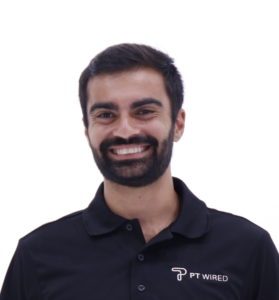
As a PT patient, Vikram Sethuraman was surprised to receive his HEP written on a single sheet of paper, handwritten by his PT. He thought to himself, “Wow, is this the best you’ve got?” and decided he was going to use his entrepreneur course to help the PT industry move into the digital age when it comes to patient engagement. He founded and developed PT Wired as a tool to improve patient compliance and engagement, thus improving patient results and PT owners’ bottom lines. Focusing on the patient experience will translate into a cascade of benefits for the patient and the business—that’s the focus of PT Wired and the custom-branded mobile clinic apps they create. In this episode, Vikram sits down with host, Nathan Shields, to tell us more about the amazing things he is doing for the PT industry and more.
—
Listen to the podcast here:
Focus On Improving Patient Compliance And Engagement With Vikram Sethuraman Of PT Wired
In this episode, I’ve got Vikram Sethuraman. He is the Founder and CEO of PT Wired. Check out his business at PTWired.com. Vikram is going to go through exactly what his company does and how it improves patient engagement and retention. I want to highlight a couple of things that came up simply because he noted and I’ll share it here. If most patients are going to drop out, they’re going to drop out within the first three visits. The average PT clinic loses $150,000 per year because patients don’t complete plans of care. I would challenge you to do whatever you can to improve patient retention through the full plan of care because the benefits are vast and amazing and will significantly improve your business.
Vikram’s app is one way to do that. I want to highlight it in this episode. Whether you use that app or whatever it might be, focus your time and effort on what you can do to improve patient retention. Track the statistic if you can because most EMR programs don’t. I would recommend you do that even manually, but whatever you can do to maintain that engagement and maintain that retention is going to benefit you and the patients. They’re going to come more often so make sure you do what you can to improve patient engagement. He’s got a ton of great info to share here on the show, but they’re on PTWired.com. We’ll go to the episode now.
—
I have the Founder and CEO of PT Wired, Vikram Sethuraman. It’s a new software program in the industry.
Thank you for having me, Nathan.
Thanks for coming. I appreciate you reaching out to me because I’m always open to talking with the founders and owners of those things that can make ownership easier and can improve our capabilities. I’ve had different owners of different products over the past years. I’ve always appreciated the insights that you guys provide and the passion that you have to help the industry. Tell us a little bit about you, Vikram. Where did you come from? Where did you get the idea for PT Wired? Share a little bit about how you started your journey into what you’ve developed.
Unlike a lot of PT software companies and organizations, a lot of these companies have been founded by physical therapists who have insider knowledge on the needs of PT clinic owners. That wasn’t the case for me. I’m not a PT nor a PT clinic owner. I got into the physical therapy space through my experience as a patient. When I was in college, I was an athlete and had a hip labral tear. I had hip surgery for repair and then 1.5 years of physical therapy. It was an intense experience for me. I got the real point at which I felt healthy and 100% again that I fully credit with physical therapy. I had the surgery and then had a lot of pain that came back. It wasn’t until I found a good physical therapist that worked closely with me that I overcame the injury and got back to full health.
During that experience, one of the first things I remember is going into PT, fresh out of my surgery, and getting a piece of paper with my exercises scribbled down on there. As a younger guy who was always on my phone, I quickly thought, “There could be an app that could be much more valuable if it had videos, notes and if I can message my PT.” My brain went off on a tangent there of all these different ideas. Coincidentally, I was in an entrepreneurship class at the time. Believe it or not, the origins of PT Wired were from a college class on entrepreneurship where my project was this PT Wired app. When I graduated, I had kept working on it. I enjoyed it. I saw some potential for it. I decided to keep working on it. Fast forward, here we are. It’s out in the market being used by over a hundred organizations, thousands of PTs and thousands of patients.
Less Dropouts. More Discharges. Click To TweetTell us a little bit about your app. What makes it unique? Is it simply a home exercise program app in and of itself or is there more to it than that?
This ties into me not being a PT. When I first went into this, it was only designed as how could this benefit me as a patient based on my experience. It was framed for the patient, but what I quickly learned is the clinic owner’s side of this. Patient satisfaction and patient experience is one part of it, but it has to be in the context of the clinic owner, their needs and values. That’s what we learned. That led us down this track of still building a home exercise platform, a powerful tool to engage patients more effectively. What we learned was the need for engagement to reduce patient dropout and an additional platform for marketing. It’s a home exercise platform where the product has grown to. It’s designed to get your patient to download the app to access their exercises, but then become a marketing platform that you can use to keep them engaged, push promotional content, ask them for reviews for Google and Facebook, ask them for feedback, and all of these other features that we can get into.
That’s how we are positioned. The big difference for us is rather than them downloading a PT Wired app or some generic app from the App Store with their exercises, every single clinic gets its own app in the App Store and the Play Store, fully branded to your practice with your logo and name. If your clinic is Active Physical Therapy, it’ll have your logo and your name on their phone. The entire idea is to sell to the patient the idea that your clinic, no matter how big or small, built this app from scratch yourself. They don’t see our name and that creates an impressive-feeling for your patient, that you’re going the extra mile to give them the best quality of care.
What I love about it is that you can create this app specific to each physical therapy clinic. I love the opportunity that you provide within that to have patient engagement. I’ve shared in the past that studies have shown that 10% to 15% of patients that come into physical therapy complete their full plans of care. That leads to hundreds of thousands of dollars of loss for the average outpatient PT clinic every year. The number comes out to around $150,000 per year on average that every clinic owner loses because patients aren’t completing their plans of care. If you can bump that number up another 10%, 15% or 20%, you can save much money without a significant amount of effort.
If you can keep those patients to keep coming in, number one, they’re going to get better results. Number two, they’re going to complete their plans of care. Number three, if they’re getting better results by completing their plan of care, they don’t only benefit you as the owner financially, but your reputation is significantly better. They’re going to say, “I achieved my goals.” That’s going to turn around and go to the doctor and turn to their family and friends and be a good marketing source. It’s a great opportunity as long as we can do as much as we can to stay engaged.
You’re saying 90% of patients don’t finish their full course of care and 30% of patients drop out within the first three visits. It is a massive opportunity for improvement. A lot of people when they’re thinking about, “How can I grow my business? How can I get more revenue for my practice?” the first thing everybody thinks about is bringing new patients in the door acquisitions. What we like to focus on is that’s important and that’s the first step, but that shouldn’t always be the main thing you’re looking at. If you focus on the patients you already have, it’s way easier to retain a current customer than acquire a new one or to sell more to an existing customer than to sell to a new one.
That’s the idea. We are trying to do everything that we can to extend the journeys of these patients to get more people to discharge rather than drop out and learning more while all in the process. Another thing to know is if a patient drops out, it’s not always a bad thing. It may mean that they reached their functional goals earlier than they were expecting to or maybe the number of visits they had allocated to them. That’s important to know. For example, if we can see on our app that this patient who is not coming in anymore had been doing all of their exercises and having great results and progressing well, that’s important to know because this is a fan. We can ask them for a Google and Facebook review.

We can check in through the messaging system on the app to see if they’re still doing well and reactivate them if not. There’s a lot of insight you can get from that. Whereas on the other end, if you can see clearly this patient hasn’t done any exercises and has not progressed, you can detect a bit earlier when they’re likely to drop out. You may intervene by sending them a message saying, “I noticed that you haven’t been logging your exercises as much. Are there any questions I can answer?” Communicate that you’re there and that you’re more accessible than only when they’re in the practice and the clinic and physically with you.
That’s cool and there is that opportunity to communicate in the app itself. To have the back and forth communication from a patient to a provider.
A full HIPAA compliant messaging platform through the app. There’s at the provider level and because it’s a custom branded app, it opens the door to other marketing efforts. For example, when COVID-19 first hit, imagine if you could instead of sending out an email, putting something on your website or send out a push notification to everybody who has the active PT app downloaded that says, “This is what we’re doing. We’re sanitizing equipment and everybody’s wearing masks. We’re closed down for now, but we will reopen.” These are messages that you can get straight to the patients on their devices in a branded way. It creates a more connected experience when they’re disengaged in between those visits.
You can send mass messages in that regard. All this is on top of the home exercise program part. You’ve got videos of each exercise and you can form templates and programs within the app itself for particular diagnoses or body parts and individualized for each patient.
We have about 5,000 exercises. We own our own video studio. We have a whole content team. We shoot 50 to 100 every other week. We’re constantly expanding the video library. We take requests free of charge. We also have the ability for users to upload their own videos if they want to. Anything that is uploaded is exclusive to that practice. It’s not like you’re putting out your content for other people to use. It’s protected and that’s all included. With regard to the exercise program creation, another important thing we know is building exercise programs quickly. A lot of PTs opts for paper because it’s fast. They can write down, hand it, and then you’re done. We knew that that was the baseline that people are working with. We have things like exercise, program templates, favorites, smart search system with filters and tags to make sure you can get to exactly what you need as quickly as possible.
You’ve had 100-plus clinics using this. What are some of the benefits and comments that are coming back to you from the owners and users of the app? What are some of the highlights that they are talking about?
From the standpoint of ease of use, that’s been one thing we were proud of, knowing how important it is to be able to build something that seamlessly integrates with the workflow of the PT. We’ve heard a lot about how quickly it’s gotten and we’ve improved it over the years. I’m not going to say that it was perfect right off of the get-go, but that’s one thing of creating exercise programs quickly. In terms of the patients, it’s all about creating super fans. Being able to get those patients and experience that gives them the wow factor.
It's way easier to retain a current customer than acquire a new one or to sell more to an existing customer than to sell to a new one. Click To TweetThey are wowed that a clinic with maybe 1 or 2 locations and 3 or 4 physical therapists has their own custom app. It blows a lot of patients away. They don’t see what’s going on in the background. They don’t know who PT Wired is. Being able to ask patients for feedback through popups on the app saying, “How are we doing from 1 to 10?” and being able to ask them to leave a Google and Facebook review. Those have been the big things that the clinic owners have loved, how impressive it is to their patients that they have their own app that’s engaging. It shows that they’re going the extra mile to deliver the best expense.
This isn’t a home exercise program app to show the patients exactly what exercises you want them to do. It also can track. The patients can click and say, “I did this exercise this day. I did this exercise and these many repetitions.” They can post that and the provider can see what’s been done.
On the app, they can mark exercises as complete. All the completion data is accessible to the provider. Another thing we do on the patient side is to give them awards and achievements as they do their exercises. They’ll get these medals and trophies as they hit streaks and the number of exercises and routines completed. Going back to the marketing elements, some clinics have incorporated that into marketing efforts where they’ll say, “If you get the 25-exercise trophy, show it to our front desk and we’ll give you a free Active PT hat or shirt,” or something like that.
They can use it for games and that tracks their progress, especially as it pertains to home exercise programs. We used to do games for coming to all your visits in a certain week or during the month, you come to all your scheduled visits. That puts another spin on it and the opportunity to gamify if you love the experience and say, “If you keep up with your home exercises, we can track you on our app.” That forces them to the app and it rewards them if they do. It not only rewards them if they go to the app, but it also rewards them if they do their home exercises, which ultimately benefits them.
We went through a Behavioral Economics focused accelerator here in Durham, North Carolina run by Duke University. We were working with these people who have PhDs in Behavioral Economics. We’re focused on that and working to make these small adjustments and feature changes to the app to maximize the impact on behavior. One of the things we did was the trophy and gamification. We’ll have patients email our tech support saying, “I forgot to mark back exercises, but I did them and I’m going to lose my streak. Can you help us out?” Another thing is for the patients. At the beginning is an educational tool. They’re looking at the app because they want to see the videos, the instructions, the list, but after they do it a couple of times, they’ll learn the exercises.
The trophies and the metals keep them still documenting everything on these. Once they learn it, if they say, “I don’t need the app until I get new exercises,” we’ll then miss out on that data. If we have them hooked to working towards a medal, a trophy or a t-shirt from the front desk, that keeps them on the app which then allows you to put promotional content saying, “We’ve got a free back pain workshop. Refer a friend to physical therapy.” All these other things that you could put on the app that they’ll still be exposed to because they’re continuing to open it to mark their exercises.
What a great opportunity to back up what you’re already doing. They’re giving out home exercise programs, but you can back that up by having a game or a reward system behind it. It automatically does, but you can tie that back to the clinic by getting something physical. I like what you’re saying about rewarding the referral system. Every physical therapy clinic that I know that’s super successful has a robust internal referral program, where patients are bringing their family and friends in for physical therapy because the team is asking for those. To be able to do that through the app, it gives you another avenue and reminder. It backs up the program that you’re already doing.

To do it in a way that is more selective and automated, we can see all the patients who are having the best experience based on the data that we’re collecting. Being able to identify those patients and then ask them for the referrals and reviews, that’s going to be the best impact for your practice.
What makes PT Wired different than other companies that are doing the same thing? There are other companies in your space. What makes you guys more unique?
It’s our branded element. You don’t go to a generic app or some different brand. It’s all under your own name. That’s the root big differentiator and that makes all the other marketing elements more impactful. For example, we’ve got a partnership with a company, Practice Promotion. I know you’ve had Neil on. They do websites, but they also put the blogs on the websites. One of the things we do with them is the blog that you get on your website is accessible on the app. You get a blog button. You can read all the articles. Even though the patient may go on there for their exercise program, then they’ll see all this other content.
That’s a big idea. You’re not going to get a patient to download an app if you say, “You’ll see our blog and any updates.” If you say, “You’ll have your home exercise program and you’ll be able to message me directly,” then they’ll download it because it’s a lot more valuable to them. Once you have it on their phone, that’s when you can do all these other things like asking for reviews, push promotional, content, give updates, these other things because they already have it on their phone as an HCP tool.
Can patients also book appointments or request appointments through the app as well?
They can request an appointment. How that works is they pick a preferred provider and the time and location. That comes through as an email to the front desk. We don’t have an integration with a scheduling platform at this time. It’s not a seamless book and appointment updated all that stuff though. That’s a goal. That’s what we want to do in the future that they can request appointments.
You’re a small business owner and you’ve dealt with a ton of other small business owners as far as the physical therapy space and talking to PT owners across the country. What are some things that you’re surprised to see that we’re not doing in the PT space or things that you utilize that you think PT owners would benefit from using if they were to come into the 21st century? A few of us are a little bit not as tech-savvy. Maybe it would benefit us to do things up to date.
The number one indicator for a patient that is likely to drop out is when they're not doing their exercise programs. Click To TweetI think project management tools are helpful for small teams, especially in a situation we’re in where you may not be as physically with your team as much. My team uses one called ClickUp. It’s a lesser-known project management software, but an up and coming one. It’s very customizable. I would highly recommend that. In terms of more general small business marketing, people would be surprised how easy it is to do something like setting up Google Ads for their practice. Something that says dry needling and rally or whatever, get a Google Ad for that. There may be much less competition than you would expect. I think to learn something that would be helpful, but those are two that we use.
Most owners either might not know the space well or not feel comfortable with some of the technology behind it. I had Jamey Schrier on where we talked about his huge recommendation during the slowdown. It is to bring things into the 21st century. He recommended a few project management apps as well to communicate with your team a little bit better. It’s not posted some paper and simply email, but tracking projects that you have, whether it’s regarded to policy and procedures, compliance, audits, you name it. Use some of these software programs to track your progress. It’s not all pen and paper. That’s essentially what you did with your home exercise program platform. Anything else you want to share with us, Vikram?
Focusing on dropout is a big thing that will help a lot of people. The number one indicator for a patient that is likely to drop out is when they’re not doing their exercise programs. It is low adherence to them. A lot of people have the mindset that they can only do much. They can only give the patient the exercises and then it’s out of their hands. I would encourage people to rethink that a little bit. There are a lot of other ways you can still engage patients. We can’t do the exercises for them, but there are a lot of small things. On our website, we’ve got a free e-book on how to optimize your home exercise program experiences. Things you can do for adherence to make patients more adherent and make them less likely to drop out. Small things like wording, cues, engagement, and tracking to create that type of experience. I would highly recommend that people pay attention to those metrics of adherence and dropout. If you work on those a lot, you may never need new patients to focus on that. They’re maybe good to go.
As I’m working with my coaching clients, I purposefully steer away from marketing efforts initially because I look at it like holes in a bucket. If you have these holes in a bucket, as far as retention and maximizing the care that you provide for each patient. If you’ve got a ton of holes, you could add more patients to the bucket but they’re going to fall out through the holes. As you start plugging in some of these holes, then you recognize that, “Maybe I can still improve and grow without much more marketing. When I do marketing, it’s going to accelerate even greater because I’m retaining those patients better.”
You’ve got to fill the holes in the bucket using something that you can retain those patients because those are the low-hanging fruit. They’re already in your clinic. You don’t have to spend a lot more money to retain them. You have to spend a little bit more time and energy on doing. I also like what you said about a lot of times we think that we can only take the patients far and then it’s out of our hands. I believe the same thing. That is the case when you’re using a pen and paper. All you can do is hand over the piece of paper with their home exercise program, saying “Here, go do these two to three times a day. Keep stretching and let me know how it goes.” I love how the app keeps you engaged with them and gives them something to go to. It’s much more than the home exercise program, which is cool. Thanks for your time. I appreciate you coming on, Vikram.
Thank you much for having me, Nathan.
Important Links:
- PTWired.com
- Vikram’s app
- Practice Promotion
- Neil Trickett– previous episode
- ClickUp
- Jamey Schrier – previous episode
About Vikram Sethuraman
 Vikram is the founder of PT Wired, the only 100% custom-branded mobile app service for physical therapy practices. Vikram founded PT Wired in 2016 after his experience in physical therapy as a patient. Today, PT Wired powers over 120 physical therapy practices as #1 highest-rated Physical Therapy Software company on Capterra, winning 2020 awards for Best Value and Best Ease of Use.
Vikram is the founder of PT Wired, the only 100% custom-branded mobile app service for physical therapy practices. Vikram founded PT Wired in 2016 after his experience in physical therapy as a patient. Today, PT Wired powers over 120 physical therapy practices as #1 highest-rated Physical Therapy Software company on Capterra, winning 2020 awards for Best Value and Best Ease of Use.
Love the show? Subscribe, rate, review, and share!
